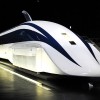The Technology Behind the Magnetic Levitation Train
You may have heard of Japan’s Maglev Train-also known as the fastest floating train in the world, clocking in at an impressive 310 plus miles per hour speed. So far the Maglev train is only notably operating as a transport system in Japan, China, and a few other countries, but recent reports suggest that the impressive floating train technology could make its way to the U.S. in the near future.
How it Works
The Maglev is named for the concept that it is built on: magnetic levitation. Magnetic levitation, the levitation of an object using natural magnetic fields, looks like magic but is actually based on some practical science and physics concepts and principles. Superconductivity and magnetism are some of the main principles behind maglev technology. When cooled to very low temperatures some materials have zero electrical resistance and consequently, expel magnetic fields. This allows superconductors in a Maglev to levitate above and below a magnetic guideway.There are two notable magnetic levitation technologies relevant to the Maglev.
- Electromagnetic Suspension - uses electronically controlled electromagnets in the train to attract to a track made of ferrous material, usually steel. This method is based on magnetic attraction.
- Electrodynamic Suspension - uses superconducting electromagnets or strong permanent magnets to create a magnetic field to push and pull the train using currents. This method is based on magnetic repulsion and powers Japanese maglev transport.
The proposed Maglev train line would run from Washington D.C.to Baltimore. Some hope to eventually connect New York to D.C. with a line that would make travel time estimates an hour and 40 minutes less than the average travel time for the current U.S. train system. There is no official decision on whether the maglev train will be coming to the U.S. but Japan has offered to bring the technology to the States with no licensing fee and unofficially proposed supporting the project with a $5 billion loan.

